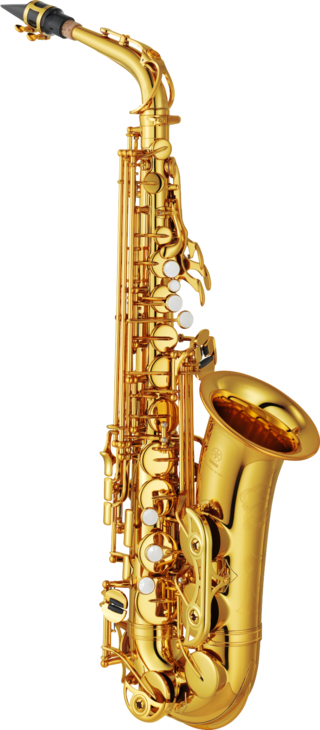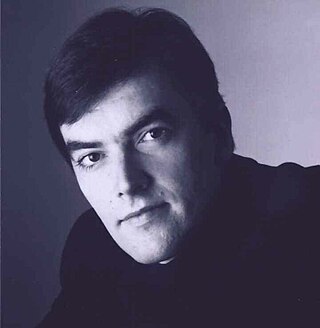
Arno Bornkamp (Amsterdam, 1959) is a Dutch classical saxophonist, the professor of the Conservatory of Amsterdam, and is considered an influential soloist in the classical repertoire. [1]

Arno Bornkamp (Amsterdam, 1959) is a Dutch classical saxophonist, the professor of the Conservatory of Amsterdam, and is considered an influential soloist in the classical repertoire. [1]
Arno Bornkamp has won many awards, including the 'Silver Laurel of the Concertgebouw' and the 'Netherlands Music Prize' among the most noteworthy. The latter enabled him to go abroad, studying in France with Daniel Deffayet and Jean-Marie Londeix, and in Japan with Ryo Noda as well as working with composers such as Luciano Berio and Karlheinz Stockhausen.
Since 1982, he has been part of the Aurelia Saxophone Quartet where he plays tenor saxophone with Johan van der Linden on soprano saxophone, Niels Bijl on alto saxophone, and Niels Merwijk William on baritone saxophone.
Among others, he recorded the CD "Adolphe Sax Revisited" with pianist Ivo Janssen, who he has been performing with since 1983. In this cd he used period instruments, which were made by Adolphe Sax.
He has given many masterclasses across the world and has been the professor of saxophone at the Conservatory of Amsterdam since 1995.

Antoine-Joseph "Adolphe" Sax was a Belgian inventor and musician who invented the saxophone in the early 1840s, patenting it in 1846. He also invented the saxotromba, saxhorn and saxtuba, and redesigned the bass clarinet in a fashion still used to the present day. He played the flute and clarinet.

The saxophone is a type of single-reed woodwind instrument with a conical body, usually made of brass. As with all single-reed instruments, sound is produced when a reed on a mouthpiece vibrates to produce a sound wave inside the instrument's body. The pitch is controlled by opening and closing holes in the body to change the effective length of the tube. The holes are closed by leather pads attached to keys operated by the player. Saxophones are made in various sizes and are almost always treated as transposing instruments. A person who plays the saxophone is called a saxophonist or saxist.

The alto saxophone is a member of the saxophone family of woodwind instruments. Saxophones were invented by Belgian instrument designer Adolphe Sax in the 1840s and patented in 1846. The alto saxophone is pitched in the key of E♭, smaller than the B♭ tenor but larger than the B♭ soprano. It is the most common saxophone and is used in popular music, concert bands, chamber music, solo repertoire, military bands, marching bands, pep bands, carnatic music, and jazz.
Frederick L. Hemke(néFred LeRoy Hemke Jr.; July 11, 1935 – April 17, 2019) was an American virtuoso classical saxophonist and influential professor of saxophone at Northwestern University. Hemke helped to increase the popularity of classical saxophone, particularly among leading American composers. He contributed to raising the recognition of the classical saxophone in solo, chamber, and major orchestral repertoire throughout the world. For half a century, from 1962 to 2012, Hemke was a full-time faculty member at Northwestern University's Bienen School of Music. In 2002, he was named Associate Dean Emeritus of the school. He retired in 2012. Throughout his career, Hemke helped build American saxophone repertoire through many composers including Muczynski, Creston, Stein, Heiden, and Karlins. Journalist and author Michael Segell, in his 2005 book, The Devil's Horn, called Hemke "The Dean of Saxophone Education in America." Hemke died on April 17, 2019.
Lawrence S. Gwozdz is an American classical saxophonist, composer, and former professor of saxophone at The University of Southern Mississippi. His successor is Dr. Dannel Espinoza.

Jean-Baptiste Singelée was a Belgian classical composer of the romantic period.
Harry Kinross White is an American-born classical saxophonist living in Switzerland.

John-Edward Kelly was an American conductor and saxophonist.
Kyle Horch is a classical saxophonist.

A saxophone quartet is a musical ensemble composed of four saxophones, typically soprano, alto, tenor and baritone saxophones. Different saxophone family members are employed to provide a larger range and a variety of tone colours. Other arrangements of instruments also exist, but are rarer. A piece of music composed for such an ensemble can also itself be referred to as a saxophone quartet.

Kenneth Tse 謝德驥 is a Chinese American classical saxophonist. Tse was mainly self-taught as a youth until he met world-renowned saxophone artist and pedagogue Eugene Rousseau in 1989. He then studied at the Indiana University School of Music with Rousseau from 1993 to 1998, where he received his BM, MM, and Artist Diploma. Rousseau has called him "a brilliant saxophonist, worthy of any stage in the world." Tse earned a doctorate degree at the University of Illinois Urbana-Champaign studying under saxophonist Debra Richtmeyer.

Tjako van Schie is a Dutch pianist and composer. He is a répétiteur at the Amsterdam Conservatory.
Claude Delangle is a French classical saxophonist. He has been teaching saxophone at the National Superior Conservatory of Music of Paris since 1988. He played in "Quatuor Adolphe Sax Paris" with Jacques Baguet, Bruno Totaro and Jean-Paul Fouchécourt. He was very implicated during the 1980s in developing the contemporary repertory of all the saxophone's family. His influences include Luciano Berio, Betsy Jolas and Japanese music. He studied Saxophone with Serge Bichon at the conservatory of Lyon and Daniel Deffayet in Paris.
Elie Apper is a Belgian classical saxophonist who is well known as a former member of the Saxophone Quartet of Belgium. The quartet was founded in 1953 and made its American debut December 9, 1970, in Fort Worth with the Youth Orchestra of Greater Fort Worth. The Quartet was founded by Francois Daneels, who was a professor of saxophone at the Brussels Conservatory.

Richard Ingham is a composer, performer and educator. He was director of the World Saxophone Congress XVI held July 2012 in St Andrews, Fife, Scotland.
François Daneels was an internationally renowned virtuoso classical saxophonist, a prolific composer, and music educator from Belgium. From 1954 to 1981, Daneels was professor of saxophone at his alma mater, the Royal Conservatory of Brussels.
Amy Dickson is an Australian classical saxophone player.
Andrew J. Allen is an American classical and contemporary saxophonist and pedagogue who is currently an associate professor of music at Georgia College & State University in Milledgeville, Georgia.
Christian Lauba is a Tunisian-born French composer and teacher, especially noted for his compositions for saxophone. His compositions often incorporate the music of his native North Africa as well as Japanese influences. He sometimes composes under the name of Jean Matitia, particularly for jazz and rag music.
Gustav Bumcke was a German composer and founder of the first German saxophone orchestra.